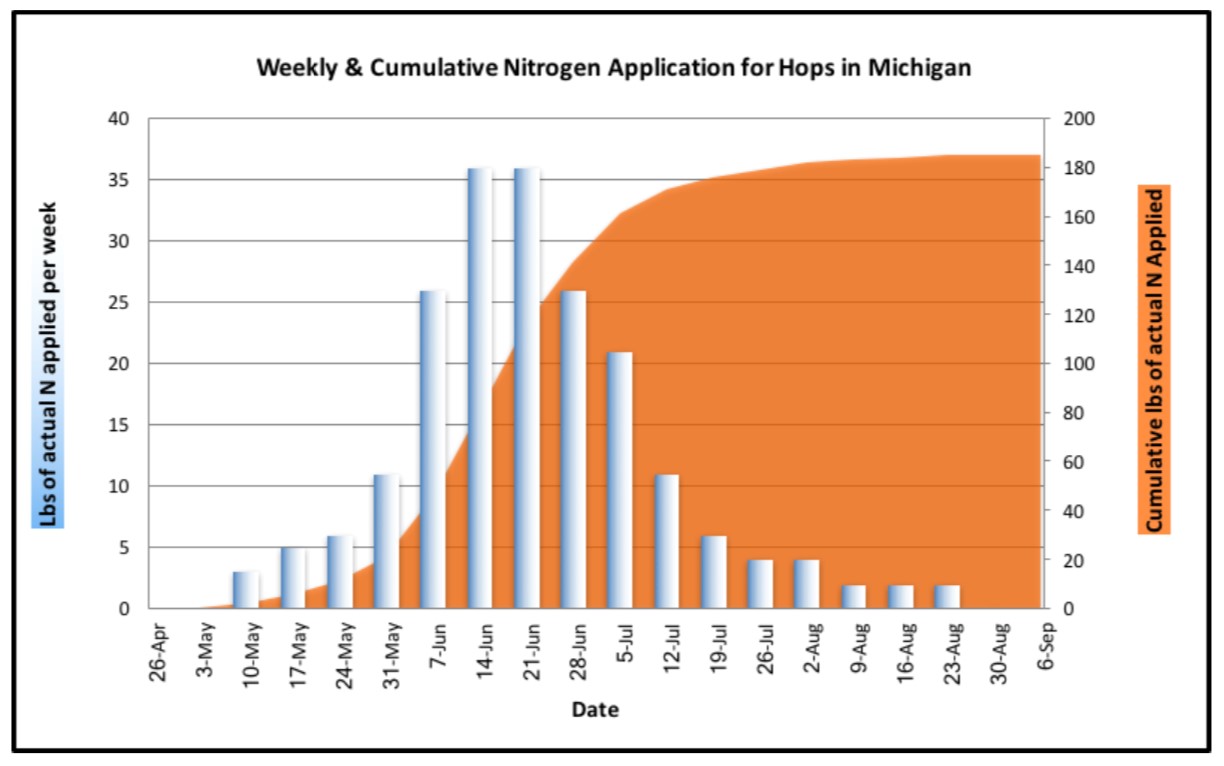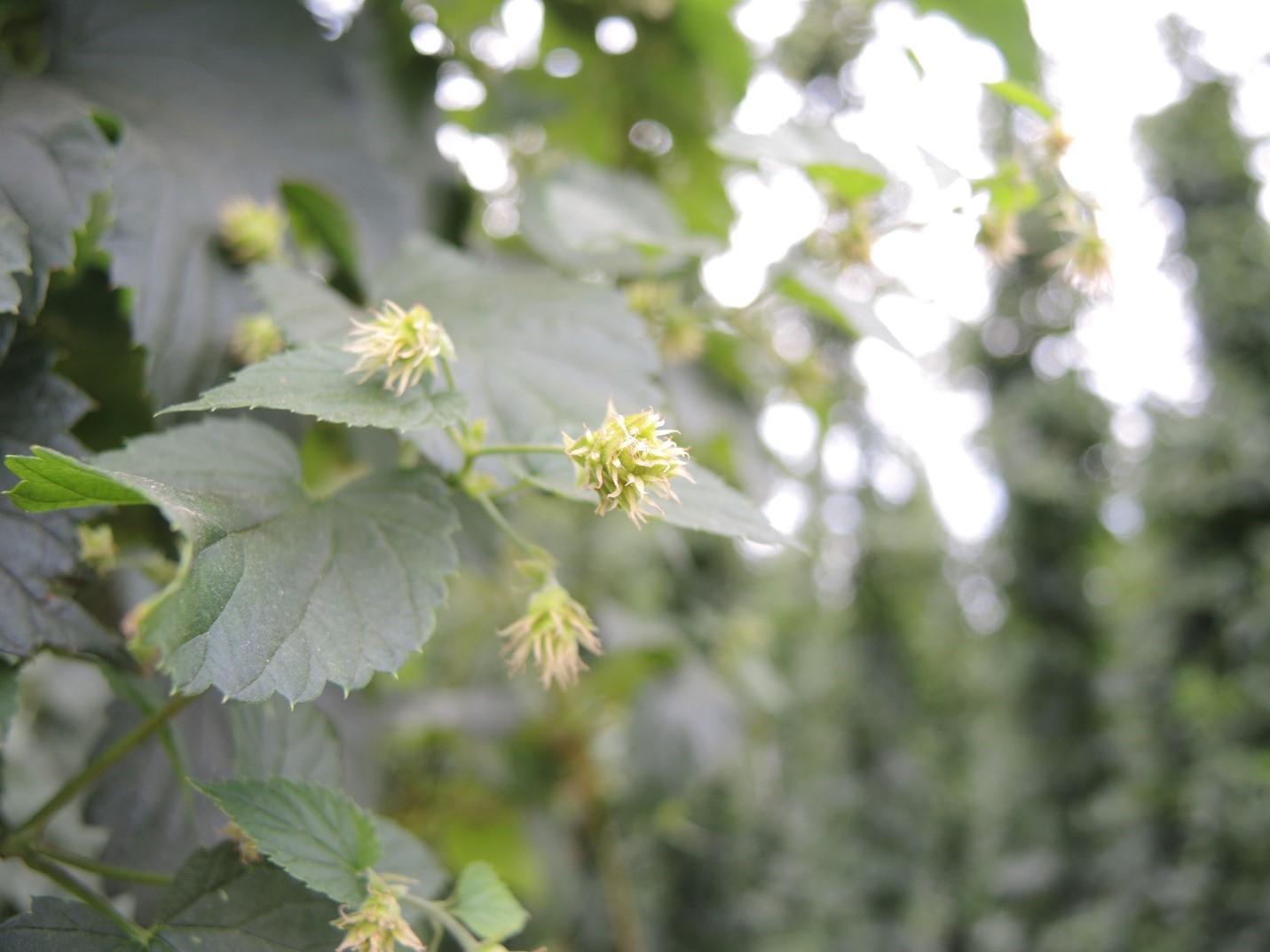Michigan hop report – July 16, 2020
Protect developing burrs from downy and powdery mildew.

Agricultural weather forecast
Temperatures over the last weeks have been unusually high, with temperatures 4-8 degrees Fahrenheit above normal throughout the state. Precipitation has been highly variable, with very dry conditions in the Thumb and intense rainfall in isolated areas. Degree-day accumulation is three to seven days ahead of average around the state. The Agricultural Weather Forecast is calling for a chance of rain in the short-term forecast, particularly in the northern Lower Peninsula and Upper Peninsula. Warm, muggy weather will arrive into the weekend with a chance of scattered thunderstorms and rain while temperatures remain hot.
Crop management
If you haven’t done tissue (leaf and petiole) testing, now is the time. Follow the leaf and petiole sampling recommendations from your plant analysis lab. Typically, sampling 1 foot below the wire after the plant has reached the wire is recommended. Foliar fertilize/fertigate to correct any nutrient deficiencies (see chart below). As a reminder, the purpose of foliar feeding is not to replace soil fertilization, but to shore up deficiencies in the near term.
|
Optimum nutrient ranges |
|||||
|---|---|---|---|---|---|
|
Nutrients |
JIH1 |
Plant Analysis Handbook IV2 |
Western Labs³ leaf + petiole |
CSIRO Australia⁴ (from Bergmann) mid-season (YML) |
|
|
Vegetative stage - prebloom (YML)* |
Reproductive stage and full bloom (YML) |
||||
|
Nitrogen (%) |
|
3.2 - 5.6 |
2.13 - 3.93 |
>4.5 |
2.5 to 3.5 |
|
Phosphorous (%) |
0.29 - 0.6 |
0.27 - 0.54 |
0.18 - 0.43 |
>0.33 |
0.35 to 0.60 |
|
Potassium (%) |
1.49 - 2.5 |
1.6 - 3.4 |
0.97 - 2.55 |
>2.8 |
2.8 to 3.5 |
|
Calcium (%) |
0.79 - 1.2 |
1.03 - 2.57 |
3.09 - 6.05 |
>0.6 |
1.0 to 2.5 |
|
Magnesium (%) |
0.24 - 0.8 |
0.29 - 0.67 |
0.55 - 1.71 |
>0.35 |
0.3 to 0.6 |
|
Manganese (ppm) |
25 - 150 |
45 - 125 |
50 - 150 |
>36 |
30 to 100 |
|
Iron (ppm) |
30 - 60 |
44.3 - 97.9 |
35.4 - 151 |
|
|
|
Copper (ppm) |
10 - 25 |
8 - 29 |
5.7 - 16.6 |
>7 |
6 to 12 |
|
Boron (ppm) |
24 - 75 |
17.6 - 63.2 |
48 - 150 |
>18 |
25 to 70 |
|
Zinc (ppm) |
24 - 50 |
23.2 - 108 |
19.4 - 57.1 |
>25 |
35 to 80 |
|
% Sulfur Sampled Basis |
0.16 - 0.32 |
0.2 - 0.34 |
0.18 - 0.30 |
>0.23 |
|
|
% Sulfur Dry Matter Basis |
0.16 - 0.32 |
0.2 - 0.34 |
0.18 - 0.30 |
|
|
|
Mo |
|
0.5 - 3 |
1 - 5 |
|
0.2 to 2.5 |
|
Na |
0 - 1400 |
|
|
|
|
|
NO3 ppm |
4000-12000 |
|
|
|
|
|
¹ Del Moro, S. 2014. Great Lakes Hop and Barley Conference. John I Haas. |
|||||
Growers should consider winding down nitrogen applications as well (see below).

Maintaining overall plant health will be critical from now until harvest. As is often said, the best fertilizer is boots on the ground, so scout your yard as often as possible. With hot, dry weather, ensure plants are receiving enough water. Finally, begin preparation for harvest. Consider lab analysis to optimize harvest date. There are many online resources that exist to help with harvest timing, such as the University of Vermont's dry matter calculator.
Pest management
With burrs developing, disease management is at the top of the pest management list this week. Throughout the state, potato leafhopper pressure remains high and Japanese beetle pressure is moderate to high. The second flight of European corn borer will begin soon and mite levels will likely build in the coming weeks.
Burr development is a critical stage for disease management. Downy and powdery mildew fungicide applications are recommended at this time to protect developing cones. Once cones close, it will be difficult to get good coverage of various fungicides. Both mildews can affect plant health, cone quality and yield. Foliar powdery mildew infections are being reported on susceptible varieties and downy mildew infections are active and widespread. At this time, lesser cone diseases like alternaria cone blight and fusarium tip blight are beginning. Keeping cones protected with broad spectrum systemic fungicides is critical. Refer to the Michigan State University Extension articles “Managing hop downy mildew in Michigan” and “Managing hop powdery mildew in Michigan in 2020” for specific recommendations.

Japanese beetle numbers are high in some locations. There is no established treatment threshold for Japanese beetles in hop. Consider that established, unstressed and robust plants can likely tolerate a substantial amount of leaf feeding before any negative effects occur. Those managing hopyards with small, newly established or stressed plants should take a more aggressive approach to Japanese beetle management, as plants with limited leaf area and those already under stress will be more susceptible to damage. It is also important to carefully observe beetle behavior in the hopyard; if burrs or cones are present and being damaged, consider more aggressive management as yield and quality are directly affected. For more information on management, refer to the Japanese beetle factsheet.
Twospotted spider mite populations will continue to build with continuing warm weather. Twospotted spider mite is a significant pest of hop in Michigan and can cause complete economic crop loss when high numbers occur. Feeding decreases the photosynthetic ability of the leaves and causes direct mechanical damage to the hop cones. Leaves take on a bronzed and white appearance and can defoliate under high pressure. Intense infestations weaken plants, reducing yield and quality. Scout carefully for mites season-long and treat while populations are at low levels, when mites are most effectively managed. Refer to the twospotted spider mite factsheet for more information and the 2020 Michigan Hop Management Guide for pesticide options.
Weather-based corn borer models are predicting that first generation flight has ended in Michigan and the second flight will begin as early as July 18 in southern Michigan. Observations in hop indicate that European corn borer larvae damage vascular tissue, disrupt the flow of nutrients and water and impede plant development. Check the European corn borer model on MSU Enviroweather, using your closest weather station to identify when more intensive scouting for moths and eggs should begin. Growers have had good luck scouting the lower canopy for adult moths at dusk and dawn, and eggs are visible on the underside of leaves. Be sure to scout both an edge row and a transect thoroughly every few days. Switch the areas scouted each time and revisit pest hot spots. For more information on European corn borer management, refer to the article “Be on the lookout for European corn borer in hops.”
Stay in touch
Want to receive more pest management information for hop this season? Sign up to receive the MSU Extension Hops & Barley Newsletter or follow us on Facebook. Also, join us this summer for monthly Live Hop Production Webinar Series.
This work is supported by the Crop Protection and Pest Management Program 2017-70006-27175 from the USDA National Institute of Food and Agriculture. Any opinions, findings, conclusions or recommendations expressed in this publication are those of the author(s) and do not necessarily reflect the view of the U.S. Department of Agriculture.



 Print
Print Email
Email




